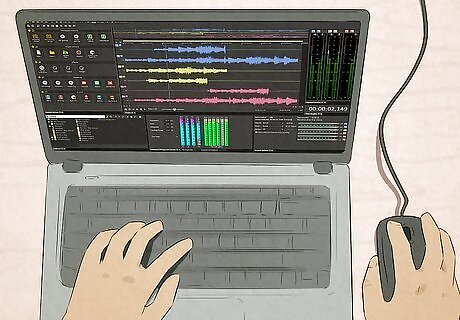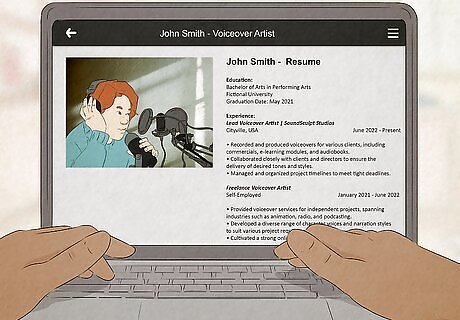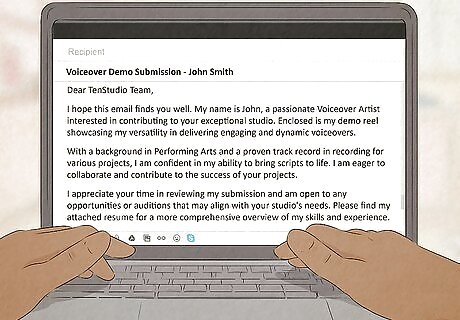
views
- Work with a vocal or acting coach to refine your voice acting skills. Practice reading new material aloud, imitating other actors, and improvising in character.
- Create a high-quality demo reel featuring your best work to send to potential clients and casting directors. Consider getting a talent agent for more opportunities.
- Attend open calls or take auditions online to land specific roles. Practice your script delivery ahead of time and warm up your voice beforehand.
Honing Your Voice Acting Skills

Practice reading things out loud for 30 minutes a day. Reading aloud effectively is essential for voice acting, especially if you’re reading cold from a teleprompter or script. Read books, magazines, or news articles out loud on a regular basis to get more comfortable with it. Practice enunciating words clearly and work on your intonation. Try changing the sound of your voice as you read for an added challenge. Read a variety of material to improve your voice; try anything from Dr. Seuss to The Hobbit. Make it sound like a performance—it’s your job to bring these words to life!

Record your voice to learn your tendencies and evaluate yourself. Try reciting monologues or reading from a script and recording it. Play it back to hear what you sound like and make personal notes for improvement. You might be surprised—the way you sound in a recording isn’t always how you sound to yourself each day. Take note of these changes and get used to your recorded voice so that you can effectively express yourself over a microphone. For example, you may realize you speak more quickly than you thought you did, or that you tend to inflect the ends of sentences a certain way.

Practice speaking from your diaphragm for a rich sounding voice. To develop the diaphragm voice, practice breathing deeply and watching your stomach rise and fall. Make sounds that come from the diaphragm, such as laughing or yawning. A voice teacher can help you project from the diaphragm when you speak or sing.

Imitate the voices of famous actors or fictional characters. Imitation helps you build flexibility, recognize pitch and tone, and gives you good material to include on your demo reel. You don’t have to be an impressionist to be a voice artist, but it’s helpful to be able to change the sound of your voice. This makes you more versatile and helps with your acting. Try to match not only the person’s voice, but also their personality so that you bring them to life rather than just imitating their sound. Start with characters or actors you know well, then explore voices you’re less familiar with for a challenge. Listen closely to learn what makes each person sound unique.

Improvise in character. Doing improv is an important skill in voice acting because directors will expect this of you in professional sessions. This skill allows you to truly embody a character and think like they do. After you’ve gotten into character, try coming up with a funny story on the spot or answering questions from a friend as that character. For example, if you are doing an impression of Kermit the Frog, you could make up a story about asking Miss Piggy out on a date.

Take acting classes or find a voice acting coach. Though voice actors never appear on screen, their acting talent helps them effectively deliver their lines. You only have your voice—you don't have other actors to work off of. The audience can’t see your facial expressions, hand gestures, or movements and you don’t have props or other tools to aid in your delivery. Remember, voice actors are actors first. Your full emotional depth and personality must be expressed solely through your voice. If you’re still in school, take classes through the theater program and audition for plays or one-acts. Or, find community theater productions to participate in. Depending on your area or school, you may be able to specifically find a voice acting coach to focus on your voice work. If there are none in your area, many coaches offer online sessions.

Take voice lessons. Weekly voice lessons will help you expand your vocal range and teach you how to control the volume and sound of your voice. Chat with several voice teachers to find the best fit for you. A good voice teacher will help you not only develop strong technique and control, but also find your unique voice. Many voice teachers can help you develop both your speaking and singing voices (you never know when you may want a voice acting role that has some singing parts!). A voice teacher will help you create a vocal warmup routine to protect your voice. These warmups might include: Flapping your lips while blowing air and making a “brrr” sound. Yawning widely and sighing while smiling to stretch your jaw. Stretching your neck and massaging your jaw to relieve tension. Holding out sighing sounds as long as you can to practice breath control.
Setting up a Home Recording Studio

Drape a closet with blankets or carpet to create a quiet "studio." Choose a closet in a quiet part of your home (away from noisy appliances) that preferably doesn’t have an exterior wall. Hang blankets on the walls and place a rug on the floor to dampen noise and help soundproof your “booth.” It’s not glamorous, but many voice actors that record from home work from their closet as well!

Invest in a high-quality mic, headphones, and recording equipment. You don’t need a lot of equipment for voice work, but a few items are crucial for producing clear, professional-sounding recordings. To get started, make sure you have: A somewhat new, functioning laptop. Old computers can overheat and create fan noise, which can ruin a good take. A high-quality microphone. Choose a simple USB mic if you’re just getting started and don’t have much money to invest. Or, try an analog mic for improved sound quality. These tend to be more expensive and require an audio interface that can connect to the mic’s XLR cable. Quality closed-back, over-the-ear headphones that are not noise-canceling. Reputable brands include Sony, AKG, or Sennheiser. A pop filter and adjustable microphone stand for your mic. XLR or USB cables as needed to connect your mic, interface (if using an analog mic), and computer.

Download your preferred sound editing software to your computer. Software can help you reduce background noise, delete unwanted material from a take, splice together pieces from different takes (called comping or compiling), and normalize the volume of your audio. Software that professional voice actors use includes: Pro Tools Audacity Logic Pro Sony Sound Forge Adobe Audition Sound Studio and more!
Making a Voice Acting Demo Reel

Record your own demo reel if you can’t pay a professional. Your demo reel showcases your talents when looking for work. It can include professional or original work, or imitations of characters and scripts that already exist. A professionally produced reel will have smooth transitions, normalized volume, and high audio quality. If you’re recording your own, use your home studio equipment. Eliminate background noises and use the highest quality equipment you have. A professional demo reel can cost hundreds of dollars and doesn’t guarantee a good demo—just a good quality recording. The content of your demo is most important.

Fit your best material into 60 seconds. Start strong with your biggest-name work first (anything from a recognizable brand, company, or project, if you have it). Follow that with something you love and that highlights your talent—anything that gives the listener a real feel for what you can do. Use the rest of your time to show off your range. A potential employer may only watch about 30 seconds of your reel, which is why your strongest material must go first. Try not to repeat similar material. If your first segment features a product description, your next segment shouldn’t also feature a description. Make the content of your demo reel relevant to a specific job. Record separate reels for different genres—zany animated characters, pleasant commercial voiceovers, dramatic acting, etc.

Edit your reel for sound quality and flow. Clean up choppy transitions, adjust the volume of each segment to be the same, and eliminate background noise. A polished, clean reel makes a good impression on any client or director. If you’re saving your audio only, save your work as both a WAV file and as an MP3. WAV files are easier to edit later, while MP3s are best for sharing files. Don’t stress too much about the tech aspect of your reel. Remember, you’re an actor first and foremost before you’re a tech expert!
Marketing Yourself & Finding Voice Acting Work

Build a resume showing your training and work experience. Make a resume listing anything you’ve done that’s related to voice work (even if you don’t have professional experience). Include acting classes or workshops, community theater roles, announcing work at school or local sports games, or anything else relevant to help you look experienced to casting directors. You could even make a YouTube channel featuring your original voiceover content (like narrating an ebook) and include a link. Headshots are a nice touch, but they’re expensive and don’t help casting directors because your appearance isn’t relevant to voice acting (unlike stage or screen acting).

Consider finding a talent agent to help find work. Your agent will notify you of casting calls in your area, help match you with the right jobs, help market you, manage your career, and negotiate your salary (while earning commission from your jobs). They will know of jobs that you can’t find on your own due to their connections. Send your demo reel and resume to talent agents in your area. Choose one that you trust and feel comfortable with. Start searching for a specialized voice acting agent once you’ve developed your voice and determined what kind of voice work you want to do (for example, TV, films, radio, video games, etc.).

Build up your online voice acting presence. Make a personal website, showcase your skills on YouTube, or market yourself on social media to share your voice acting content. If someone has heard of your work, you want it to be easy for them to look you up and see what you can do. Having pages online dedicated specifically to your voice work will help you market yourself.

Send your demo reel and resume to every studio in your area. If you are willing to travel, send your demo and resume anywhere in the country. Be prepared to wait for an answer and to face a lot of rejection—studios get hundreds of demos and you may or may not be what they are looking for. Just because they don’t respond right away doesn’t mean they will never be interested in your work. If they don’t have a part for you currently, they may consider you in the future. To cast a wider net, upload your demo to your personal website or share it with your personal networks to reach as many people as possible.

Consider moving to a city with a strong voice acting scene. Although many voice actors can record from home or on the road, it can still be helpful to be right in the center of things for networking and convenience. Some of the top cities in the US for voice acting are Los Angeles, New York, Dallas, and San Francisco.

Make an effort to network with other industry folks. Building connections with fellow voice actors, producers, and casting directors in the industry is vital for finding work and advancing your career. Introduce yourself to everyone you meet and, if possible, exchange contact information to make yourself accessible. Be kind and professional to everyone you work with and connect other voice actors to paid opportunities when you can. Later, they’ll repay you with the same.
Finding Voice Acting Audition Opportunities

Attend an open call. An open call is an audition that anyone can attend. Be prepared for there to be many people and to be seen for only a short amount of time. Even if it isn’t very likely to book a role at an open call, it’s still great practice and will help you get used to auditioning and start getting yourself seen by casting directors. To find open calls in your area, look at a website like Backstage for listings.

Audition online for remote or far away roles. Since voice acting can be done with just a microphone, you can audition from home (or the road). Peruse audition listing websites like Voices for opportunities anywhere in the world. The online marketplace is changing the way casting occurs, and auditioning online is a great option when you don’t live in a major acting city.

Audition as much as possible. You will likely need to take many auditions to book just one gig, and then as soon as you complete your job, you have to start auditioning all over again. Embrace the audition process and go to as many as possible. This will keep you sharp and your voice in shape for when you do land a job. The more auditions you attend, the higher chance you have of being hired. Audition even for roles that you aren’t sure you’re right for. You never know what a casting director is looking for. Remember to rest your voice between auditions so you don't overuse it.
Nailing a Voice Over Audition

Review the script and know exactly how you’ll read it ahead of time. Make sure your voice is warmed up and you are hydrated. Some auditions consist of only saying one line, so it’s important to know that you can nail it ahead of time. This will also ease your nerves in a stressful audition environment. Have other dialogue prepared besides the script in case casting directors want to see what else you can do. Get inside the character’s head and go beyond the words on the page. Who is this character? What’s important to them? Why are they saying these words? Write down your ideas about a character to work through the important aspects of them. This will help bring the character to life.

Show up on time. When attending an audition, punctuality is key. Plan to arrive 10-15 minutes ahead of time. This will give you a chance to get settled and even go over your script.

Dress appropriately. Even though looks aren’t relevant for voice acting, your overall impression says a lot. Look professional and keep in mind what character you are auditioning for. For example, if you’re auditioning for a ninja, you don’t need to wear a costume, but wearing a black button-down shirt would be a good way to interpret that role with professional clothing.
Pros & Cons of Voice Acting

The pros Voice acting is a competitive but lucrative field with unique rewards and perks. If you’re serious about voice acting, consider the following benefits of the industry: Working from home (or anywhere you can use your home studio setup). Flexible hours. You can choose when to record or take auditions, and professional in-studio sessions often only last a few hours. Being your own boss. You decide which roles or jobs you take and what you want to specialize in. Competitive pay. Many voice actors make $200–300 per hour, although you may only have sporadic gigs at first amounting to $10k-20k per year. With consistency, you may be able to transition to full-time voice acting work after about 2 years.

The cons Like any field, voice acting has its drawbacks. Consider the following: Unstable salary. If you’re largely freelancing or don’t have an agent, you may go long stretches without big, lucrative projects. Stiff competition. Lots of talented people want to be voice actors. Plus, AI voices are being used for small projects more and more frequently. Expensive equipment. Investing in a high-quality home studio can cost hundreds or even thousands of dollars, depending on the equipment you choose. Unpredictable vocal health. If you lose, strain, or damage your voice, you’re out of work until you’re recovered. Isolation. Voice actors spend many hours alone in a small booth or closet recording (although for in-person sessions, you’ll have a director giving you instructions).
Types of Voice Acting Work

Voice actors can work for a variety of media like TV, radio, or films. While many voice actors are able to work in a variety of settings, many specialize in certain types of voice acting work to carve out a career niche. Some of the major types of work to choose from include: Television: TV shows, commercials and advertisements, documentaries, and more. Animated films: original character voices, foreign language film dubs. Radio: advertisements, promos, and occasional audio dramas. Video games: talking characters, instructional voice overs, or narration. Podcasts and audiobooks: written blogs converted to podcasts, audiobooks for publishing companies. Phone systems, announcements, or e-learning: public transit announcements, automated phone menus, workplace training videos, and more. Live events: sports announcing, theatrical announcements, and more.




















Comments
0 comment